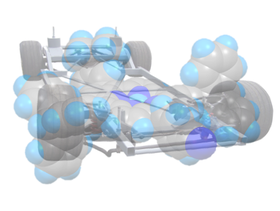Materials Science 2022/03/14
The 2nd International Nanocar Race (Nanocar Race II), organized by the European FET OPEN project MEMO (Mechanics with Molecules), will take place in Toulouse, France on 24-25th March 2022, in which ultimately small molecular machines will run for 24 hours in a competition for distance. Eight teams from around the world will be participating in the scientific competition.
Prof. Gwenael Rapenne (Division of Materials Science, Nara Institute of Science and Technology (NAIST)) leads the Franco-Japanese Team, made up of researchers from NAIST and Paul Sabatier University (UPS), France, under the framework of the international collaborative laboratory established between NAIST and CEMES-CNRS (UPS). The team participates in the race with a newly designed and synthesized dipolar nanocar, called the "Blue Buggy" due to its color.
Nanocars competing in the race are single molecules, each of which consists of 100-1,000 atoms with a distinguishable front and rear. They are only a few nanometers in length, one million time smaller than an ant, and have chemical structures designed to move on a track surface when electrons are provided from the tip of a scanning tunneling microscope (STM). Nanocar drivers control the motion of nanocars using the electrons.
Beyond the competition, this scientific and technological challenge is an opportunity to advance research in the use of molecule-machines (ultimate stage of miniaturization), capable of rendering many services. Eventually, it will thus be possible to use it to improve the efficiency of motors and computers and make impressive energy savings. Thus, it is likely that in the next few years, these machines will be used in the construction of electronic circuits or the deconstruction of industrial waste, atom by atom.
Rapenne is one of the key persons who developed the idea of the contest many years ago (Joachim and Rapenne, 2013. ACS NANO). In 2017, he participated in the 1st Nanocar Race as leader of the French team.
"The propulsion of a nanocar is achieved by the excitation of vibrational modes of the molecule or by the repulsion or attraction between the nanocar and the STM tip, but since the principles governing the motions are not well understood, control and movability are very difficult to manage," explains Rapenne.
"For the 2nd Nanocar Race, we have newly designed and synthesized a high-performance dipolar nanocar, called the Blue Buggy. To hope to win the race, we must not only be fast but also be able to maintain control. The design is then a compromise between two contradictory requirements," he continues.
The competition will be broadcast live (https://youtu.be/ofwBAOi01_o). The 1st Nanocar Race in 2017 was followed live by more than 100,000 people on a dedicated YouTube channel. The Nanocar Race also offers the opportunity to promote research in mobile machines at the nanoscale.
###
Resource
- Information about the Franco-Japanese Team is available at the following website:
http://www.naist.jp/kensui/nanocar_race/en/index.html





